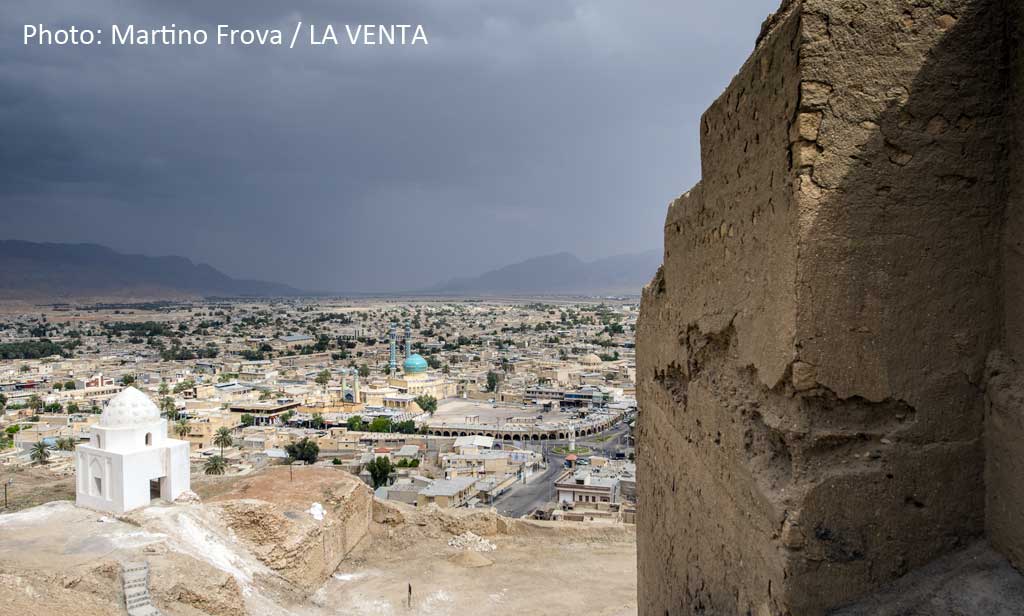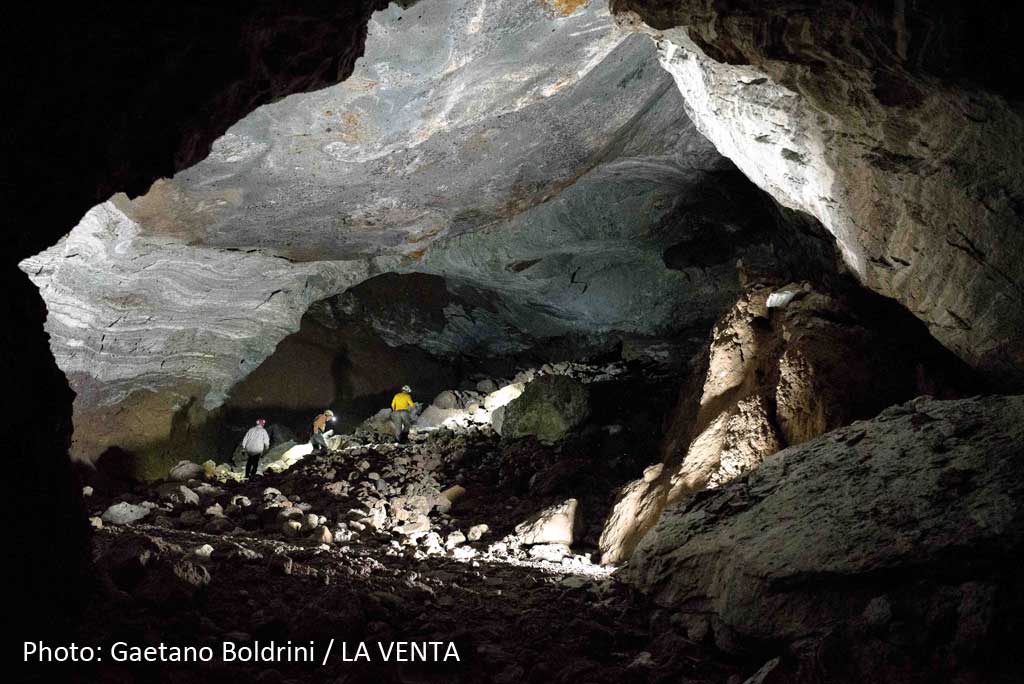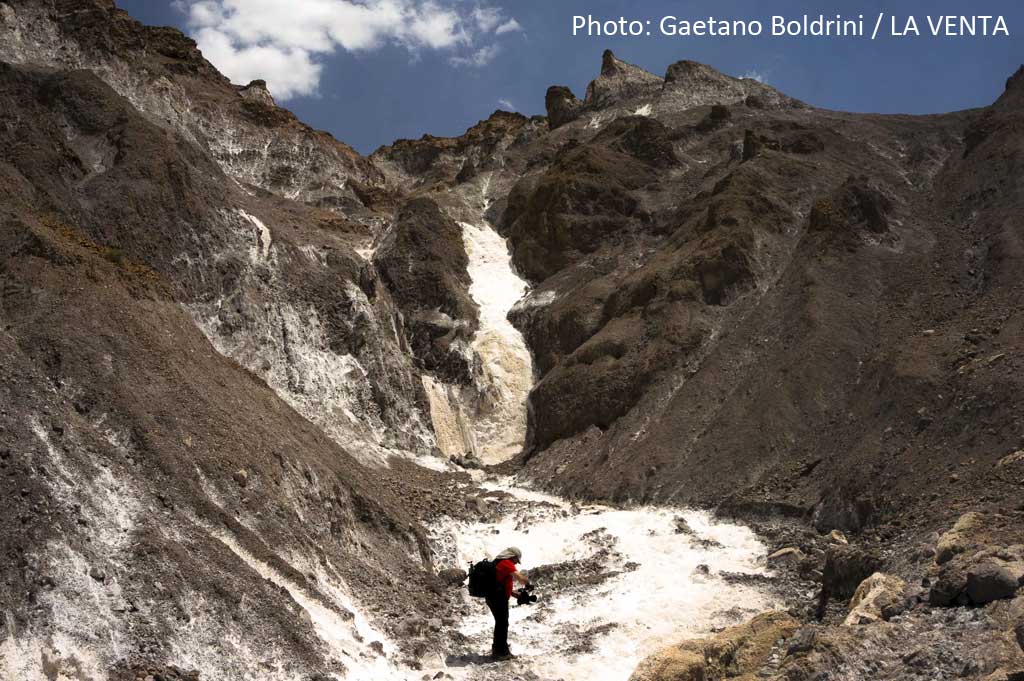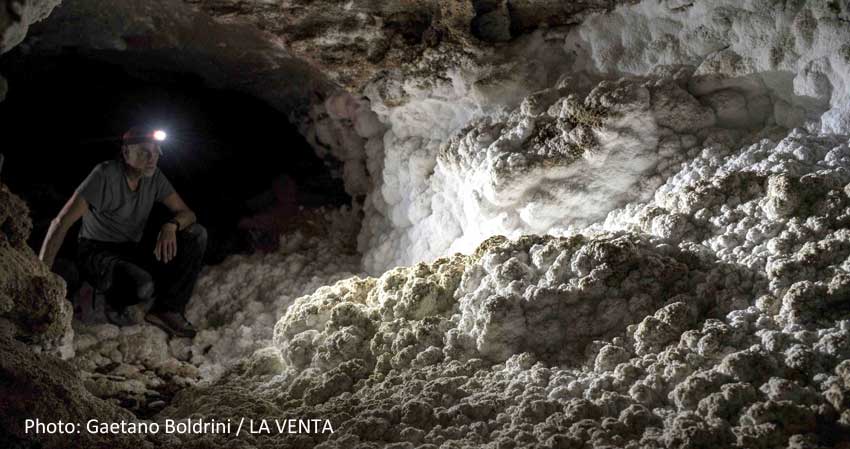Recently returned from Iran, tired but enthusiastic, we brought home important results: no less than a thousand, no abysses or complex caves at the time, but in many ways much more…
The group of members La Venta who dedicated himself to climb the Iranian salt diapers, thanks to the help of his friend Yones Shariatmadari, an expert speleologist from Teheran, consisted of: Gaetano Boldrini, Martino Frova, Giuseppe Giovine, Luca Imperio, Luca Massa and Leonardo Piccini.

In just ten days of expedition, whose purpose was to know the characteristics and peculiarities of the area and the Iranian salt diapires, we were able to get an idea of ??the consistency and the amount of work that awaits us to complete a study. accurate of the phenomenon.
Mountains of salt, resurgences of hypersaline water, pouring of white crystals like snow, sun, dry mountains and without a drop of water. A salinized ground, as frozen, which requires a progression on crumbly salt crusts or on sharp rocks to get to identify the entrances of the caves; but also mountains littered with sinkholes, sinkholes or breakthroughs, unfortunately often blocked by debris, which have frustrated our research. With patience we finally managed to enter and descend some deep wells but we found not a few difficulties in the equipment due to the friable rock and the newly cemented debris present at the start of the wells, then, once arrived at the salt, no problem, as in the ice, perfect the "multimonti" nails (reusable) for the preparation of rope down…

The inevitable companion of every day the water, without at least three liters in the backpack not even move, there the heat is the master; the area is desert, rare bushes and even rarer small trees, only rocks and sun, but luckily every now and then there is some ravine to protect yourself in the hottest hours. A landscape from post-nuclear war, to Mad Max (for those who remember it)…
Fortunately, our expedition doctor has never had to engage in his role, just constantly remind everyone to feed well, constantly hydrate and, very important, always cover up and do not expose unnecessarily and I would say stupidly in the sun, which does not forgive.
Through our scientific manager, Leo Piccini, we have identified some areas of great interest: two salt domes in the area just south of Shiraz, and one about 200 km southeast, near the ancient city of Lar: a drop in the sea ... in this part of Iran there are more than 62 saline diapers, of which only very few are speleologically explored. These first steps, however, have given us important information: we are, in fact, able to understand how these wells should be faced in salt, which often have the entrance dug into a "cappellaccio" of breccias and cemented debris, which collapse inside and they tend to block the fund and the possible continuation.
Since the early days we have been working closely with the speleological groups of Teheran and Lar, where we also held a short course in speleological technique.

From the middle of the expedition, thanks to the interest of the Iranian Speleological Society, the collaboration with the University of Shiraz began. We were fortunate to have with us an Iranian geologist who helped us during some patrols. The Iranian geologists have surveyed all the diapires and studied the main ones, but they have not explored the cavities encountered, so a possible collaboration between La Venta and the University will be an important opportunity for the future.
At the end of the expedition we met in Shiraz for a meeting with the professors and researchers of the University and representatives of the Iranian Speleological Society, to discuss and take stock of the work to be planned together. On this occasion, films, projections, photos and studies were presented, in order to better understand the phenomenon of salt and to make known to them the activity of our association.
Throughout the expedition, thanks to Martino Frova, Luca Massa and Gaetano Boldrini we have made a complete documentation of all the activities carried out, with photos, videos and filming with the drone; material that we will share with the Iranian speleologists and the University of Shiraz.
At the end of these intense and busy days, the group has dragged to the airport for the return, accompanied to the landing in Italy by programs and ideas for the near future. Great enthusiasm, but also the awareness of a big work to do to return a report on what has been done.
In conclusion, a nice working group, no longer very young, but efficient; exceptional Iranian hospitality, contacts between Associations and Universities, between people and groups, partnerships between friends, I would say all positive signs that let us glimpse for the future a great multidisciplinary work in this fascinating country.
Luca Imperio

Rock salt, or halite, is one of the most soluble minerals in nature. In a liter of water at room temperature you can melt up to 350 g, more than a kilogram in just three liters of water (to give an idea, calcium carbonate can melt, when it's okay, about half gram in one liter of water). For this reason the outcrops of salt rocks are practically relegated to the driest areas of our planet, among these: the Middle East, the Atacama desert in Chile and certain areas of North America. In other areas, rock salt, which is in fact a fairly common mineral, is only found in depth, as in the rich mines of central and eastern Europe, exploited since the ancient Celts.
Another important property of rock salt is that it is relatively light, about 2.2 g / cm3 versus 2.7-2.8 g / cm3 of the most common minerals and rocks. For this reason the deep deposits of salt tend to rise pushed by the weight of the overlying rocks, forming a sort of large dome-shaped "bubbles", which take the name of diapiris, or salt domes, and which reach up to the surface. The salt, in fact, at medium-high pressure behaves like a viscous fluid, a little 'as does the ice, so much so that it can give rise to real flows, which are not by chance take the name of "salt glaciers" , even under the effect of its own weight. The saline diapers are therefore very particular geological structures, since they have a very rapid dynamics compared to other geological phenomena, and therefore they are very studied by geologists.

In the world, the area with the highest concentration of saline diapers is southern Iran, along the offshoots of the mighty Zagros chain. Here the salt forms domed structures which, when ascending, have deformed and "pierced" the overlying rocks, forming species of rock salt islands in the midst of sedimentary rocks of a different nature.
Once exposed to the surface, the rock salt is quickly dissolved by rainwater, giving rise to karst forms and caves similar to those of limestone, but characterized by a much faster evolution, even in situations, as in this area of ??the Middle Ages. east, where rainfall is small or occasional.
Compared to other areas of the world, the salt deposits of southern Iran are characterized by the thicknesses and the differences in height between high infiltration zones and the valley bottom, where the springs are located, which in some cases exceed 700-800 meters. It is therefore likely that in these areas, which already house the longest cave in salt in the world (Tri Nahacu Cave, more than 6 km long, on the island of Queshm) there may also be the deepest. It is therefore an area with a remarkable speleological potential whose study has just begun and which at the moment has affected only some areas, mostly in the coastal strip overlooking the Persian Gulf.
With these premises, a first prospection of the La Venta Association took place with the aim of experiencing firsthand the geography of these places and starting the contacts for a future project of exploration, documentation and study of the salt caves of Iran, on the road already started by speleologists and researchers from the Czech Republic in recent years.
A careful analysis of the aerial images on Google Earth had allowed us to identify some of the most promising areas in which speleological research was not carried out. The remarkable detail of the photos left in fact to identify precisely those that looked like deep wells on the top surfaces of the larger diapires and real sinkholes fed by small closed basins. On the margins, however, the white riverbeds of some streams signaled the presence of springs where the outgoing water deposited iridescent deposits of salt.

The first area visited, Deh Kuyeh Diapir, located about 200 km south-east of Shiraz, not far from the town of Lar, was literally riddled with sinkholes and wells, some even relatively deep, but the first descents immediately collided with two big problems. The salt, in fact, does not appear on the surface, but is covered by a thickness of several meters of a sort of deposit made up of fine debris and blocks of various freshly cemented rocks. Therefore, the rigging of the wells required a lot of caution and not a little imagination, in order to be able to plant nails in the few relatively safe points of rock, obtaining reliable weapons. The other problem is that, over time, the debris, falling into the wells, almost always caused the closure after a few tens of meters of depth at most. A nice well, with a slightly smaller entrance, allowed us to go down about sixty meters, but even here, where it seemed to see the beginning of a gorge, the fallen debris from above closed every continuation. In the same area, a prospection of the highest area, at about 1700 m altitude and reachable with two hours of walking, has revealed the existence of a vast plateau with hundreds of depressions and wells, but with a detrital coverage thicker than 10- 20 m Only a meticulous job will allow to find the "good hole", if it exists. In the area we have also identified some sources at the level of the plain (about 1100 m altitude), unfortunately not passable. From one of these comes out a trickle of hypersaline water that has formed some beautiful castings.
The other two areas investigated, Kornasiah and Khoorab diapir, are located just south of Shiraz. Even here we were faced with thick covers of debris that cover the salt deposits and that inexorably plug most of the wells and sinkholes present. The feeling is that there are large empty spaces underneath, but entering it is another story.
In a large sinkhole, already identified by aerial images, after a first jump of 12 m, we leaned on a well of 75 meters deep, almost all in the void, probably one of the major known in salt. At the base a large gallery, unfortunately collapsed after a few tens of meters, has again disappointed our expectations. Also in this case the equipment for the descent was not easy, being in the first thirty meters of this cave dug in a sort of breach where only a few stones here and there, a little 'more cemented than others, allowed the anchorage of ropes.
On the southern edge of the Konarsiah area, we have identified a beautiful hypersaline source, captured for the extraction of salt, with a flow of 1-2 l / sec: how to say that from that source come out something like 40-50 tons of salt every day (about 20-25 cubic meters), about 18,000 tons in a year, provided that the flow rate is relatively constant! Not bad for a small spring…
The last day, before returning to Shiraz and meeting with the Iranian speleologists and researchers to discuss the future of the project, we saw a quick survey in the area of ??Khoorab, where we finally identified an accessible source, which we explored for a hundred meters and continued in a narrow mill. A top gallery houses a colony of bats whose appearance is quite different from that of the inhabitants of our caves.
In conclusion, it can be said that the speleological potential of the whole area is noteworthy, but the exploration of existing karst systems does not seem trivial or rapid, but this is nothing more than an extra incentive to move forward.
Leonardo Piccini
Sponsors: Ferrino, Scurion, DeWalt, Intermatica, Amphibious.











